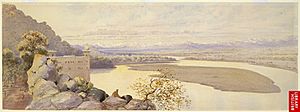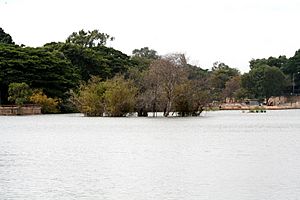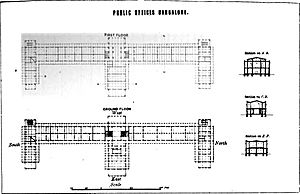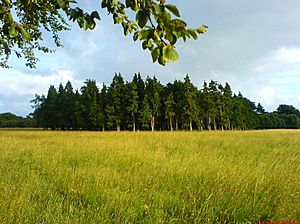Richard Hieram Sankey facts for kids
Quick facts for kids
Sir Richard Hieram Sankey
|
|
|---|---|

Albumen Carte de visite from the National Portrait Gallery
|
|
| Born | 22 March 1829 Rockwell Castle, County Tipperary, Ireland |
| Died | 11 November 1908 (aged 79) St George's Hospital, London |
| Interred |
Hove, Sussex
|
| Allegiance | |
| Service/ |
East India Company Army British Army |
| Years of service | 1846–1884 |
| Rank | Major-general (honorary lieutenant-general on retirement) |
| Unit | Madras Sappers Royal Engineers |
| Commands held | Royal Engineer detachment, Kandahar Field Force |
| Battles/wars | Indian Rebellion of 1857 Second Anglo-Afghan War |
| Awards | Knight Commander of the Order of the Bath Companion of the Order of the Bath |
| Other work | Chairman, Irish Board of Works |
Lieutenant-General Sir Richard Hieram Sankey (22 March 1829 – 11 November 1908) was an important engineer and officer. He worked for the East India Company's army in British India. Later, he joined the British Army after a big uprising in India and when the British government took over control.
Sankey built many important structures. For example, the Sankey Tank in Bangalore, India, is a large water reservoir named after him. He designed it to provide water for the city. He also designed the high court building in Bangalore, known as Attara Kacheri.
Contents
Early Life and Education
Richard Sankey was born in 1829 in Rockwell Castle, County Tipperary, Ireland. His birthday was March 22. He was the fourth son of Eleanor and Matthew Sankey. His mother's family had many military men. His father, Matthew Sankey, was a barrister, which is a type of lawyer.
Richard went to school in Dublin. In 1845, he joined the East India Company's Addiscombe Military Seminary. This was a special school for training military officers. He was very good at painting and even won awards for it there.
Career as an Engineer in India

In November 1846, Richard Sankey became a second lieutenant in the Madras Sappers. This was a group of military engineers. He then trained with the Royal Engineers in England. He arrived in India in November 1848.
He worked on many engineering projects. In 1850, he became a Superintending Engineer in Nagpur. He studied the local geology and collected fossils. In 1856, he became the head of the East Coast Canal in Madras.
In May 1857, he was promoted to a higher role in the Public Works Department. During the Indian Rebellion of 1857, a major uprising against British rule, Sankey played a key role. He built embankments and bridges across rivers like the Yamuna and Ganges. These structures helped troops move quickly. He also built shelters for soldiers along the Grand Trunk Road. His work helped the British forces during the conflict. He received several awards for his bravery and skill during this time.
After the rebellion, he worked in Burma as an engineer. In 1861, he became a captain and was posted in Calcutta. Later, he became the chief engineer in Mysore. Here, he developed a system to manage old Indian water systems. He surveyed areas to understand water flow and drainage. In 1862, he officially joined the Royal Engineers. In Mysore, he built many roads, buildings, and water tanks.
In 1870, he visited Australia. He was asked to lead a group studying water supply in Victoria. He also advised on railways and flood control.

In 1877, he became an under-secretary for the Government of India. In 1878, he was promoted to secretary in the public works department in Madras. He also led the Royal Engineers during the Second Anglo-Afghan War. For about five years, he lived in Madras. He became a member of the legislative council and a Fellow of the Madras University. He also helped improve the Marina area, gardens, and Government House grounds.
He was promoted to major general in 1883. He retired from the army in 1884 with the honorary rank of lieutenant general. He also received a special award for his service in India.
Sankey married Sophia Mary in 1858. After she passed away in 1882, he married Henrietta in 1890.
Key Contributions to Bangalore
Sir Richard Sankey made many lasting contributions to the city of Bangalore, India:
- St. Andrew's Church, Bangalore (built in 1864)
- Cubbon Park (designed in 1864)
- Sankey Tank (completed in 1860)
- Bangalore Museum (built in 1877)
- Mayo Hall (designed in 1870)
Later Life and Legacy
After retiring from the army, Sir Richard Sankey returned to Ireland. He became the chairman of the Board of Works, overseeing many public projects. For his work in Ireland, he was made a Knight Commander of the Order of the Bath in 1892. He also worked on projects in Mexico.
Later, he settled in London. He passed away at St George's Hospital in 1908. He was buried in Hove, Sussex.
Sir Richard Sankey is remembered in Phoenix Park, Dublin, Ireland. A group of trees there is called Sankey's Wood. There is also a plaque from 1894 hidden among the trees.
Images for kids





